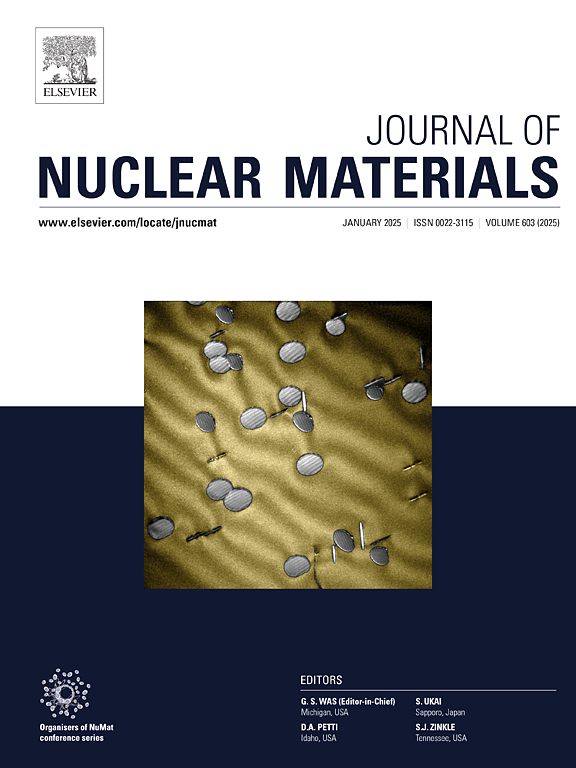Temperature effects on radiation damage in HCP-zirconium: A molecular dynamics study using a fine-tuned machine-learned potential
IF 2.8
2区 工程技术
Q3 MATERIALS SCIENCE, MULTIDISCIPLINARY
引用次数: 0
Abstract
Zirconium has become an indispensable material in nuclear reactors due to its excellent corrosion resistance and low neutron absorption cross section. In this study, we fine-tune an efficient machine-learned interatomic potential for the pure Zr system. This potential demonstrates better performance in predicting defect properties, allowing us to conduct a comprehensive investigation of primary radiation damage through molecular dynamics simulations. We explore the threshold displacement energies of Zr at different temperatures and find that the variation in with temperature is closely related to defect migration and recombination process. A series of cascade simulations with primary knock-on atom energies from 1 to 40 keV is conducted to investigate the effect of temperature on defect generation and clustering behavior in pure Zr. The results show that 10 keV serves as a critical value which large vacancy cluster begins to emerge, revealing distinct regimes of energy-dependence for defects. At low primary knock-on atom (PKA) energies, higher temperatures reduce both the number of steady defects and small-sized clusters. In contrast, at high PKA energies, the steady Frenkel pairs number increases gradually with temperature, along with a greater occurrence of small-sized defect cluster. Moreover, it is likely to form large-sized defect clusters at lower temperature. Our findings provide critical insights into the irradiation damage mechanisms in Zr, offering theoretical guidance for the optimization of its radiation resistance.
温度对hcp -锆辐射损伤的影响:使用微调机器学习电位的分子动力学研究
锆以其优异的耐腐蚀性能和较低的中子吸收截面,成为核反应堆中不可缺少的材料。在这项研究中,我们对纯Zr系统的有效机器学习原子间势进行了微调。这种潜力在预测缺陷特性方面表现出更好的性能,使我们能够通过分子动力学模拟对初级辐射损伤进行全面的研究。我们探索了Zr在不同温度下的阈值位移能,发现Ed随温度的变化与缺陷迁移和复合过程密切相关。为了研究温度对纯Zr中缺陷产生和聚类行为的影响,在1 ~ 40kev的一级碰撞能级范围内进行了一系列的级联模拟。结果表明,10 keV是开始出现大量空位团簇的临界值,揭示了缺陷的不同能量依赖机制。在初级撞击原子(PKA)能量较低的情况下,较高的温度既减少了稳定缺陷的数量,也减少了小尺寸簇的数量。而在高PKA能量下,稳定的Frenkel对数Ns随着温度的升高而逐渐增加,小尺寸缺陷团簇的出现也越来越多。此外,在较低温度下可能形成大尺寸的缺陷团簇。研究结果为Zr的辐照损伤机制提供了重要的见解,为Zr抗辐射性能的优化提供了理论指导。
本文章由计算机程序翻译,如有差异,请以英文原文为准。
求助全文
约1分钟内获得全文
求助全文
来源期刊

Journal of Nuclear Materials
工程技术-材料科学:综合
CiteScore
5.70
自引率
25.80%
发文量
601
审稿时长
63 days
期刊介绍:
The Journal of Nuclear Materials publishes high quality papers in materials research for nuclear applications, primarily fission reactors, fusion reactors, and similar environments including radiation areas of charged particle accelerators. Both original research and critical review papers covering experimental, theoretical, and computational aspects of either fundamental or applied nature are welcome.
The breadth of the field is such that a wide range of processes and properties in the field of materials science and engineering is of interest to the readership, spanning atom-scale processes, microstructures, thermodynamics, mechanical properties, physical properties, and corrosion, for example.
Topics covered by JNM
Fission reactor materials, including fuels, cladding, core structures, pressure vessels, coolant interactions with materials, moderator and control components, fission product behavior.
Materials aspects of the entire fuel cycle.
Materials aspects of the actinides and their compounds.
Performance of nuclear waste materials; materials aspects of the immobilization of wastes.
Fusion reactor materials, including first walls, blankets, insulators and magnets.
Neutron and charged particle radiation effects in materials, including defects, transmutations, microstructures, phase changes and macroscopic properties.
Interaction of plasmas, ion beams, electron beams and electromagnetic radiation with materials relevant to nuclear systems.
 求助内容:
求助内容: 应助结果提醒方式:
应助结果提醒方式:


